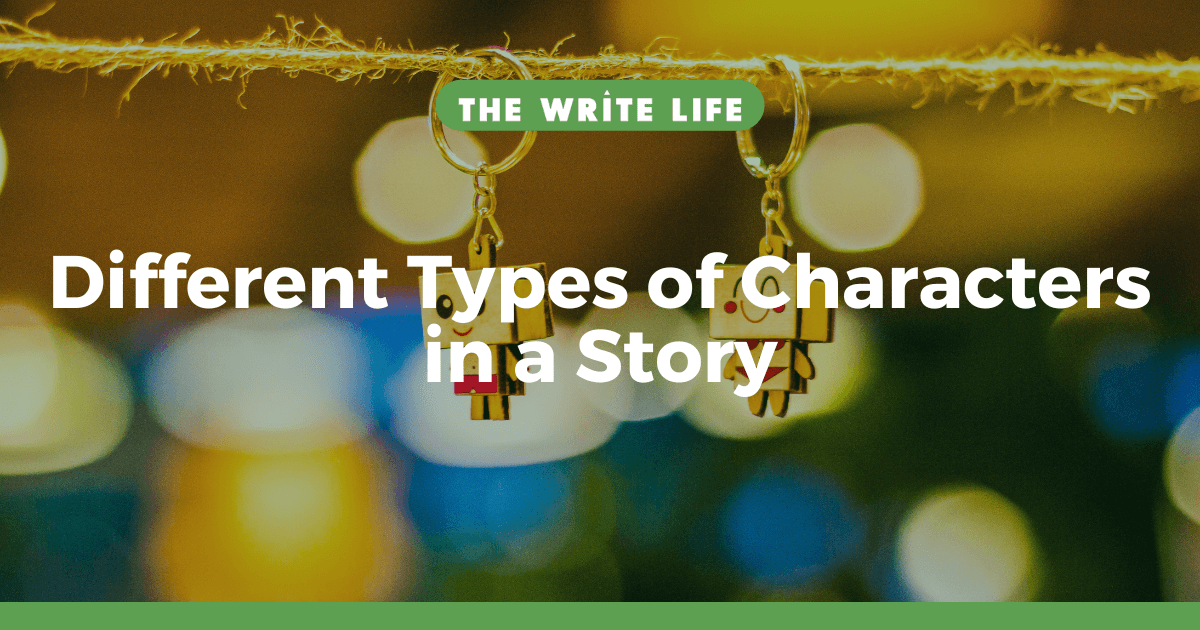When you’re writing, you have different tools and components at your disposal—plot, structure, character, theme, etc. You manipulate these things to make your work the best it can be, and having a good understanding of how all of these components work means you can move them around with intention.
Characters are sort of like pawns. To know what to do with them, you need to know what they’re doing in your story—what purpose do they serve, and what are readers going to expect from them based on similar characters from other stories?
In this article, we’re going to talk about the different types of characters in a story that you’ll encounter across mediums (T.V., movies, books, etc.). Not only will this make it easier for you to analyze the media you encounter, but it’ll help you more intentionally and thoughtfully craft your own work.
Character Roles
Let’s first talk about characters by the role they play in your story. This is the function they serve in terms of the story, and these terms are used across genres and mediums (a protagonist is called a protagonist whether you’re talking about a children’s adventure book or a grisly war movie).
These roles often overlap—antagonists may start out as deuteragonists, for example, and in a series like Heroes of Olympus by Rick Riordan, characters who are protagonists in one installment may not get as much on-page time as they do in another.
Protagonist
The protagonist is the main character of your story. They’re the ones driving the plot and undergoing the most change, usually. The story is about them, and the story’s main arc will be tied directly into their own internal character arc. A story told from multiple points of view may have multiple protagonists—if this is the case, each character should have similar weight.
Examples: Luke Skywalker in Star Wars, Miles in Looking for Alaska by John Green
Antagonist
The antagonist directly opposes the protagonist. We see this in superhero movies all the time: the antagonist wants to destroy the world while the protagonist wants to save it. They often need to be defeated by the protagonist in order for the plot to resolve. The antagonist’s chief job is to create problems for our main characters.
Examples: Sauron in Lord of the Rings, Logan Roy in Succession, Nurse Ratched in One Flew Over the Cuckoo’s Nest by Ken Kesey
Deuteragonist
A deuteragonist is the character who is secondarily important to the protagonist. This is often the protagonist’s closest friend and companion. Because of their proximity to and influence over the protagonist, they play an enormous role in the plot, and they often undergo significant change themselves—conflict between the deuteragonist and the protagonist is a common subplot meant to steer the protagonist toward the inner change needed to succeed in the climax.
Examples: Dr. Watson in The Adventures of Sherlock Holmes by Sir Arthur Conan Doyle, Sam Gamgee in Lord of the Rings
Tertiary Characters
Tertiary characters are the third most important characters in a story. These characters don’t often see a lot of character development, or at least not particularly complicated development—they mostly exist to flesh out the world and add texture and depth to the setting, as well as to deliver one or two pieces of information to the main cast. They might be townspeople, henchmen, or miscellaneous council members.
Example: Pintel and Ragetti from Pirates of the Caribbean: the Curse of the Black Pearl
To know how to name characters, click here.
Character Archetypes of the Hero’s Journey
An ‘archetype’ is sort of like the blueprint. An ‘archetypal mother,’ for example, would be the picture of a mother—not necessarily the perfect mother, but the perfect example of a mother. In The Hero’s Journey, Joseph Campbell outlines eight major character archetypes which pop up in fiction.
The Hero
The hero is usually the protagonist. This is the character who has to battle their internal struggles to overcome the antagonist and save the day in the end—the reader generally roots for them and wants them to win. They tend to be aligned with moral good.
Examples: Marvel’s Captain America, Percy Jackson from The Lightning Thief by Rick Riordan
The Mentor
This character exists to offer advice and guidance to the hero. They don’t usually have much of an arc unto themselves, instead serving as a plot device—they show up when the hero needs a key piece of wisdom to help them on their internal journey. This character tends to be older, but that’s not necessarily a rule.
Examples: Yoda from Star Wars, Gandalf from The Lord of the Rings
The Ally
The ally is the hero’s right hand man. This is usually the deuteragonist—this person wants to help the main character achieve their goals, and their interests are tightly aligned with the hero’s. If they become misaligned, this is the source of enormous conflict, as the ally and hero tend to depend on one another.
Example: Nick Carroway from The Great Gatsby
The Herald
The herald isn’t always a character—this can be a person, but it could also be an object, like a message. The herald’s purpose is to herald, or signal, an upcoming change for the hero. This typically happens at the start of the story—a character’s living their regular life until the herald calls them to adventure.
Examples: the letter from Hogwarts in Harry Potter, the summons from Fiona’s parents in Shrek 2
The Trickster
The Trickster is there for comic relief. Sometimes this is also the protagonist’s best friend (you see this a lot in buddy-cop movies), since having a sidekick who tags along to make wisecracks is an easy way to keep the mood light. They may also provide emotional support or serve some other function, but this character is the one you think of as ‘the funny one.’
Examples: Donkey from Shrek, Jaskier from The Witcher
The Shapeshifter
While most of the main characters undergo change in some form or fashion, the shapeshifter’s change is different—they cross the line between ally and enemy. Someone who starts out as an ally and is later found out to always have been an enemy is an example—so is a redeemed villain who always had a heart of gold.
Examples: Zuko from Avatar: The Last Airbender, Rhea Jarrell in Succession
The Guardian
The guardian, also known as the threshold, is a character who stands between the hero and his destination. They warn the character about the danger ahead, either explicitly in the form of a verbal warning, or implicitly by their dangerous nature. The hero has to defeat, outsmart, or otherwise work around the guardian to proceed with the quest.
Examples: Cerberus from The Lightning Thief by Rick Riordan, The Minotaur from The Lightning Thief by Rick Riordan
The Shadow
The shadow character is the antagonist, or the antagonistic force. This is the threat which looms over the story and which ultimately must be defeated by the hero. They also represent an opposite world view from that of our protagonist—usually this looks like a morally good protagonist who represents evil.
Examples: Darth Vader from Star Wars, Gollum from The Lord of the Rings by J.R.R. Tolkein
Character Tropes by Genre
Character archetypes, as you can see by the examples listed above, span over many genres and mediums. Within specific genres, though, these archetypes take the shape of character tropes.
Tropes are commonly used elements within a story—they’re building blocks to which a reader will instantly assign meaning based on their previous interactions with that trope.
To know how to create believable worlds for your character, click here.
Character Tropes in Sci/Fi Fantasy
The Wizard
The Wizard usually acts as a mentor figure. They tend to be older (sometimes centuries old or immortal), and they often have some supernatural abilities which give them transcendental knowledge which they can impart to the protagonist. They also tend to be loners and live in seclusion.
Example: Gandalf from The Lord of the Rings
The Chosen One
The Chosen One is a trope where the main character is literally destined for the plot. They’re the only person who can, for some plot-provided reason, save the day. The Chosen One will often grapple with this enormous responsibility, and their decision to take on that responsibility or abandon it will make up their inner arc.
Example: Harry Potter
The Reluctant Hero
The Reluctant Hero is one who doesn’t want to save the day. They want to go about their regular lives, but eventually, the plot demands that they take on the role of the hero.
Example: Shrek
The Dark Lord
The Dark Lord is a very powerful wizard, sorcerer, or magician-type character who also usually serves as the story’s antagonist. They tend to represent evil, and they tend to have an all-powerful aura about them—Dark Lords often have armies, henchmen, and so on which must also be reckoned with during the quest.
Example: Voldemort
Character Tropes in Romance
Secret Billionaire
The Secret Billionaire knows that they’re a billionaire, but their love interest and the story’s secondary characters don’t. This means that the love interest falls in love with them purely for their personality and not for their money, which is what the Secret Billionaire is used to, and which is why the Secret Billionaire will resist the exposure of their wealth so hard.
Girl-Next-Door
The girl-next-door is a little naive, friendly, and helpful. They’re not supermodel beautiful or insanely talented in any particular regard—their strengths come from their down-to-earth goodness, patience, and sensibility. These are common protagonists in romance novels, since they function as great self-inserts for readers.
Newbie
The newbie trope, also known as the virgin trope, is where we have a character (most often a young woman) who is completely new to the world of romance, sex, and dating in general. When handled poorly, we get characters like Anna from Fifty Shades, whose naivety feels almost supernatural in nature and who is frequently infantilized for the purpose of fetishization.
Character Tropes in Horror/Thriller
The Scholar
The scholar character is the one who does a ton of research—they might be a professor, lab assistant, or doctor—and provides the protagonist with this information at some key point in the story. In a supernatural horror, this information might be lore about the entity haunting the cast. In a realistic thriller, it might be a detective or police force sharing what they know with the protagonist.
The Amateur Sleuth
The amateur sleuth, commonly the protagonist, has no background in solving crime. They’re often an everyday person who becomes forced to investigate the mystery themselves when proper authorities aren’t an option, either because they refuse to take on the case or prove incompetent.
The Lonely Monster
The lonely monster is usually the antagonist. This character, as the name implies, lives alone, and if that loneliness is highlighted by the story, it might give them a sympathetic edge. This might be a ghost kicking around an old asylum, a monster hiding out in an abandoned warehouse—they still often need to be defeated by the heroes, but they might not feel great about it.



